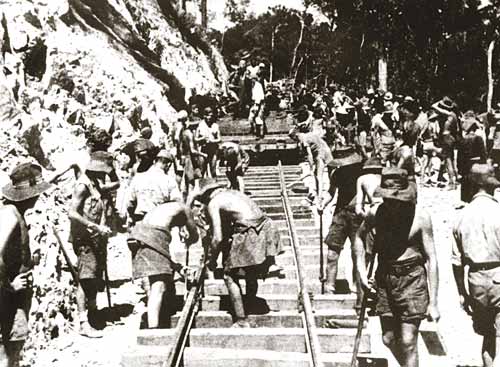Siblings to retrace WWII ‘Death Railway’ route

THE THAI-BURMA RAILWAY is a WWII transport route barely visible today, but its construction is indelibly tied to Australia and other nations. Known as the ‘Death Railway’, it was built at a hefty price; about 16,000 Allied prisoners of war and 90,000 Asian labourers died by the time of its completion in 1943.
Now, nearly 70 years later, two Australian siblings, Luke Nowell and his sister Rachel, will walk its length, in remembrance of those workers who died building it. They will leave on Anzac Day.
Prisoners of war literally worked to death
In the early stages of World War II, Japanese forces took control of Burma (now Myanmar), a valuable passageway westward, and a country rich in mineral resources.
The sea voyage between Japan and Burma was a dangerous one, vulnerable to attacks from the allied forces. To establish a safer transport route, the Japanese set about joining the Thai and Burmese railways so they could supply their troops and strengthen their military hold. The project could only be finished in that timeframe with conscripted POW and local workers, who were forced into labour camps.
About 13,000 Australians were sent to work on the railway; almost 2700 died. The workers were forced to endure appalling conditions, forced by commanding officers to hack through rock and forest for days on end. Exhaustion, malnutrition and cholera outbreaks all contributed to the massive death toll.

c1943. Australians and British POWs work on the Burma-Thailand railway track.
Many of this A Force group, were captured in Java.(Credit: Australian War Memorial)
Walking the Death Railway
Five years ago Luke, met one of the survivors of the camps, an Australian named Stan Carylon. Affected by his story, Luke made a documentary about Stan’s experience and Rachel composed the music for the film. The two soon decided to take the experience of telling the story one step further, by walking the path the prisoners were forced to construct so many decades ago.
Luke and Rachel will walk 300km, from Ban Pong in Thailand to Song Khla Buri, about 30km from the Burmese border. “For the first part of the route we will be following the still existing railway,” Rachel says. “After that the route is unknown, so we’ll walk through villages, mountains, jungle and remote areas.”
Unable to look at a topographical map beforehand (Thailand has restrictions on buying maps from outside the country) the two won’t be able to plan an exact route until after they arrive. While Luke and Rachel can’t recreate the prisoners’ experience, they have predicted some challenges of their own.
“We’re likely to encounter the monsoonal season – the heat and the wet are going to be a huge hurdle to get over,” says Rachel. “And the challenge of where to camp will be a constant struggle, but we’re going to ask permission to use farmland and hope that some locals even invite us to stay with them.”
Self-proclaimed expedition amateurs, the two have been physically preparing themselves for the several months. Rachel has been using her base in the UK to complete walks in Morocco and Andorra, and Luke trains daily from home in Sydney.
The two will record their experiences on they way with photos, videos and notes. Luke plans to make a documentary, and Rachel hopes to publish a book.
RELATED STORIES




